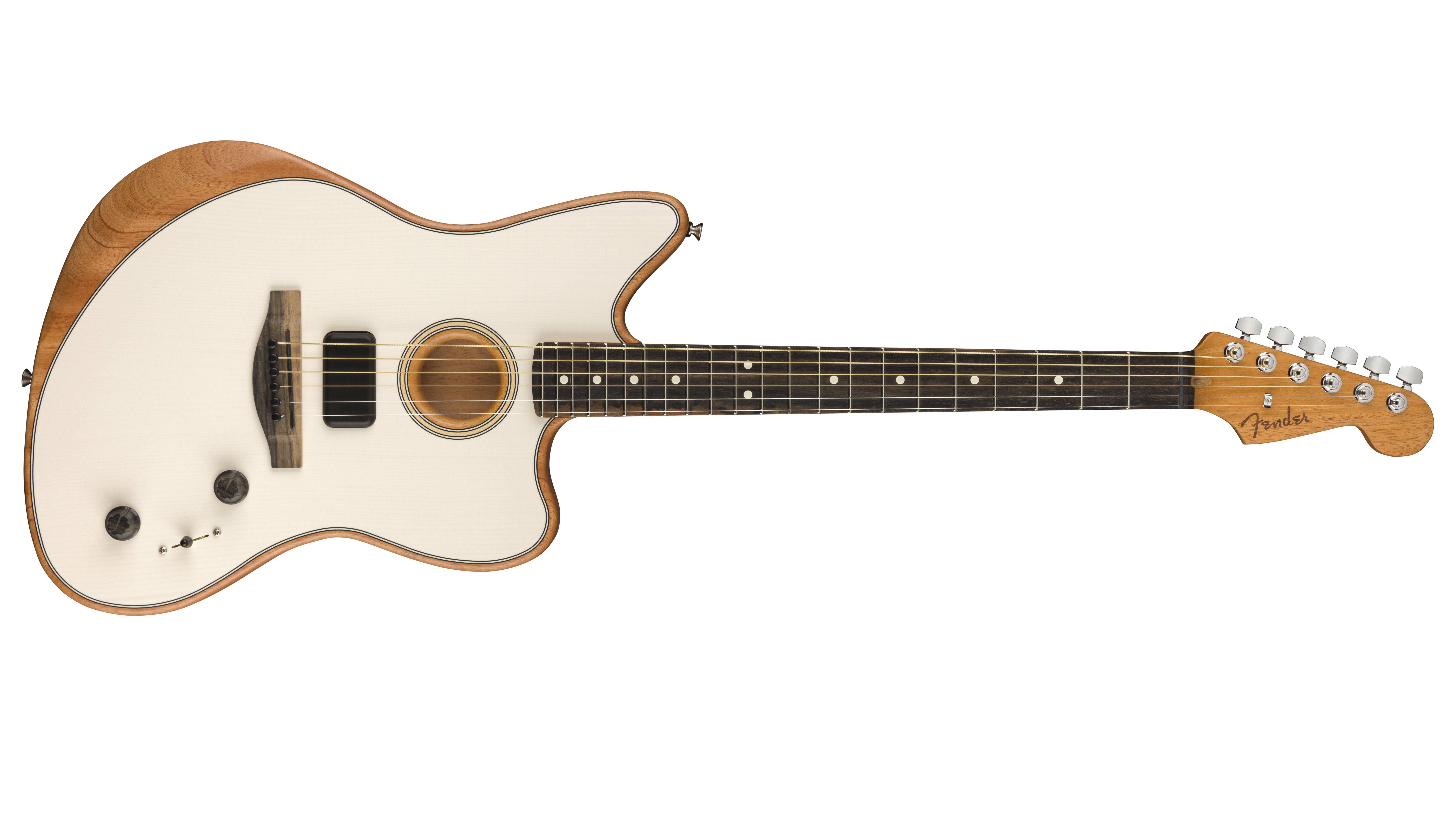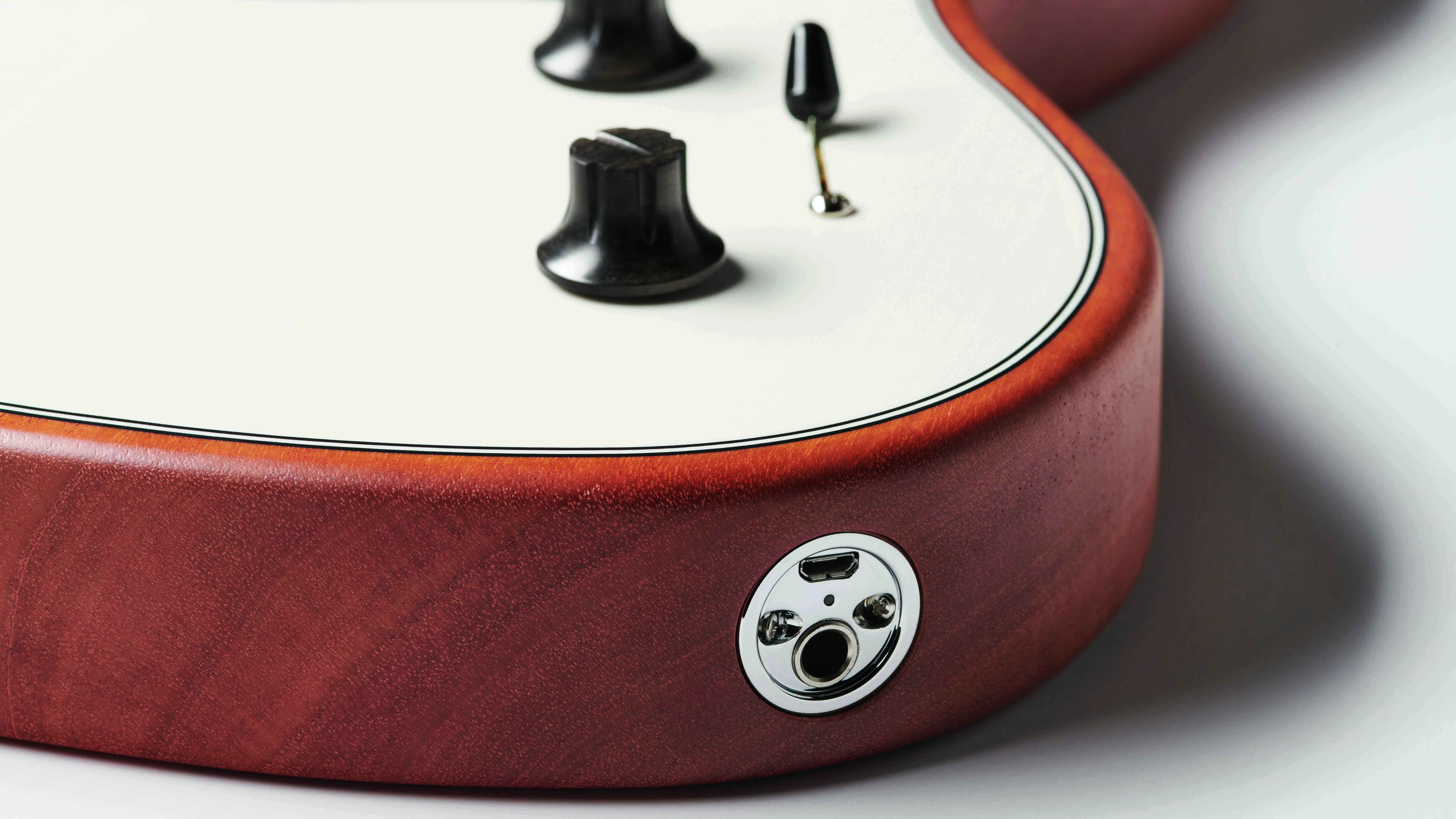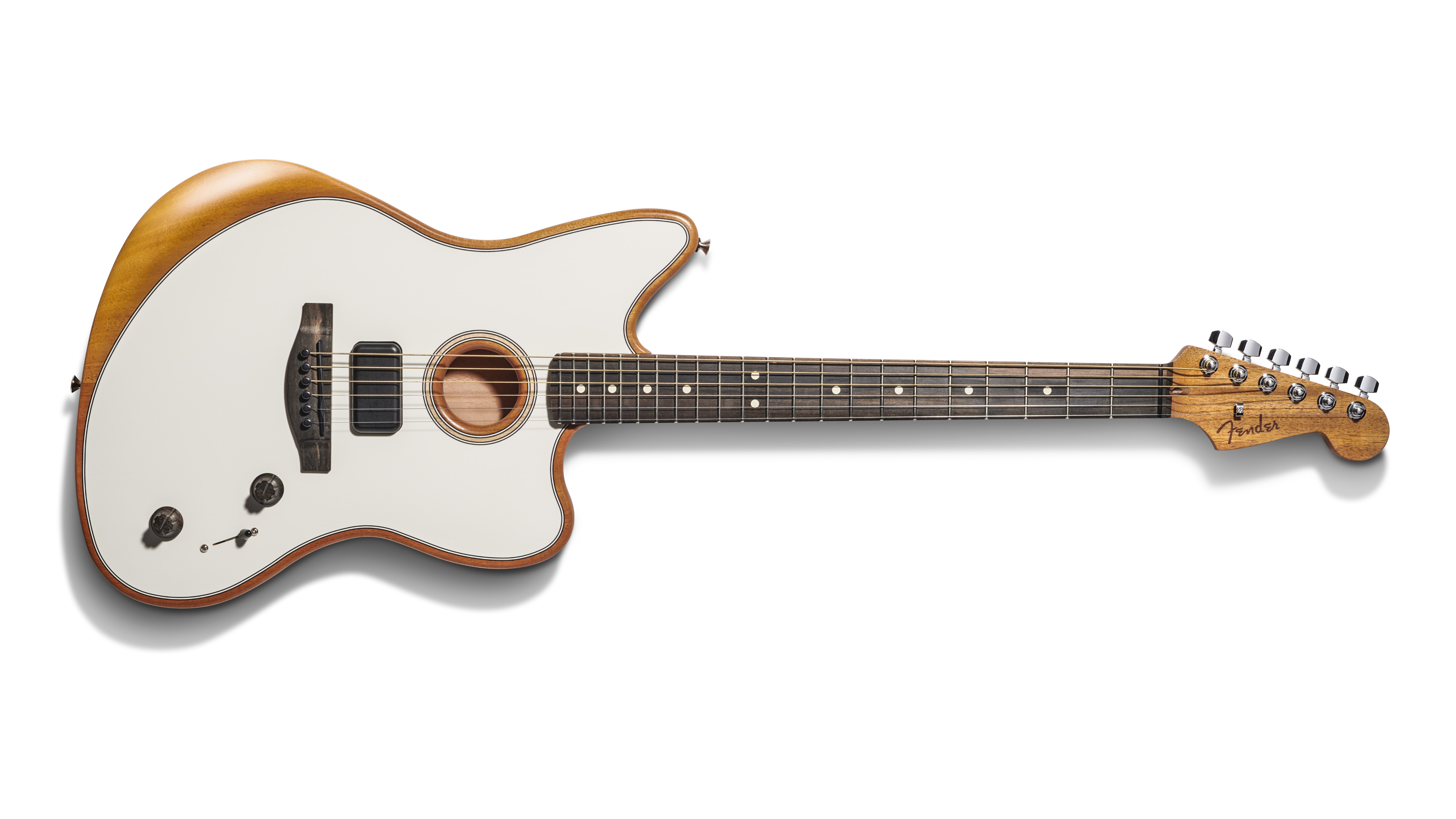MusicRadar Verdict
The Acoustasonic Jazzmaster is a serious investment but for the right player, it’s a wise one. If you lean on a looper for live performance, it could be a real gamechanger. If you’re in a function band and want to more between worlds with ease, it’s a solution. Above all it’s a really enjoyable and inspiring guitar to play.
Pros
- +
An acoustic guitar with a humbucker that sounds great
- +
• A range of highly usable tones, easily dialled in
- +
Richer unplugged tones than previous Acoustasonic models
- +
The neck offers great feel and playability
Cons
- -
We're not fans of the the Artic White finish in this context but there's four other options available
MusicRadar's got your back
What is it?
Best of 2021: The talking points that follow bold innovations are always welcome in the world of guitar, and when they come from one of its two biggest names with an iconic history of design, there’s even more of a stir.
With the Acoustasonic Telecaster and the Stratocaster that followed, Fender managed to reimagine familiar designs in a very different way. Each presented a distinct proposition with the tones they offered with transducer, piezo and magnetic pickups in play, and both combined the concepts of an electric and acoustic guitar in way that hadn’t been attempted before. What can a Jazzmaster Acoustasonic bring to the story?
It could equate to the most ideal Fender platform for this technology yet
A new Tim Shaw-designed Acoustasonic Shawbucker for starters; presenting what is potentially the boldest combo of sounds yet. And as the largest bodied model to date, it could equate to the most ideal Fender platform for this technology yet.
Performance and verdict
One feature that is very much absent here is a tremolo. And for some, you can’t have a Jazzmaster without one. But this is a different kind of Jazzmaster and with the Acoustasonic concept requiring a more traditional acoustic bridge this just wouldn’t compute.
The larger Jazzmaster shape soon feels like a more natural home for a soundhole than the Strat version and unplugged, it sounds it too – there’s a deeper low end and warmer tonality than the previous Acoustasonics that make it a great go-anywhere option. And we'll talk more about that later.
The visual contrast of the mahogany drawing attention to the upper arm contour here works, though out of the four available options, we feel our test guitar’s Arctic White finish is the least successful of the new range. It looks somewhat flat and even jarring in context with the attractive stained mahogany grain. We’d aim for the superlative Ocean Turquoise, Natural, contemporary Tungsten or more traditional Tobacco Sunburst that all make the combination work more successfully for us.

• Fender Acoustasonic Telecaster
The original Acoustasonic model offers a single-coil sound with a light crunch that can be dialled in.
• Fender Acoustasonic Stratocaster
Another winner from Fender with its other iconic silhouette.
• Martin SC-13E
The acoustic titan's own revolution in radical design offering unrivalled fingerboard access for a non hybrid guitar with the Sure Align neck system.
The appeal of the satin finish on the Deep 'C' neck isn’t in doubt, a great playing neck with a tactile, organic feel with the mahogany grain and satin urethane finish. It combines with a contoured neck heel to provide the greatest electro acoustic guitar higher fret access you'll find. Or should we say acoustic electro?
Want all the hottest music and gear news, reviews, deals, features and more, direct to your inbox? Sign up here.
How you view the balance here may well be influenced by the action to begin with. The body shape and neck profile is electric alright, but the action here our of the box might raise even SRV’s eyebrows. It’s hard work to play and because of the acoustic-style bridge and compensated saddle, you may assume you don’t have the freedom to adjust it. But you do…
Acoustasonics feature Fender’s Micro-Tilt feature to adjust the pitch of the neck via an allen wrench hole in the neck plate. It’s a quick fix; a modern solution to the old shim solution, and we soon find it changes things considerably to make this a guitar that offers both electric and acoustic guitar worlds equally in feel and sound unplugged.
The level of resonance we retain unplugged with lower action is a very pleasing discovery and even with Fender Dura-Tone Coated Phosphor Bronze 11 gauge acoustic strings we found it plays like a Jazzmaster with a very smooth, fast neck, and sounds akin to a parlour acoustic. Even if you're used to lighter gauge electric sets like us (we're partial to 9.5 gauge electric guitar strings), it feels comfortable. So we’re excited to plug it in to discover what more it can do.
Ok, let’s plug in and cut to it – it’s got a humbucker, so can you get metal tones on this thing!? Yes! We can’t help but smile we dive straight into Boogie Rectifier waters with this. It’s hot, raucous with metallic bite in the treble too. Sorry, we couldn't resist, but let’s calm down and just rewind a bit as that’s only part of the story here that we need to explain…

There's a lot of options to choose between, before you even consider the actual details of the tones here
The Acoustasonic Jazzmaster offers five pickup positions, with two voices (A and B) each that you can move between using the Mod (effectively a blend) control knob. At extremes it’s all of each, but between them it’s up to you. There's a lot of options to choose between, before you even consider the actual details of the tones here and all the voices here are new to this new Acoustasonic model. So let’s break them down:
The first position is humbucker focussed with Electric Fat / Semi Clean in position A and Overdriven Electric in B. Yes, it’s an overdriven tone coming from the guitar.
Position 2 is Lo-Fi piezo / Lo-Fi Piezo Crunch (the latter voice aiming to capture a ‘thin-body acoustic amp pushed through an electric amp’.
Position 3 is a Rosewood Auditorium as Voice A without the guitar’s body sensor pickup in play, voice B utilises the Body Sensor for percussive possibilities.
Position 4A is based on a Mahogany Jumbo and B is a Mahogany Small Body. Finally, voice 5a is a rosewood dreadnought and 5B is a ‘warmer’ Mahogany Slope Shoulder Dreadnought.

We really like this humbucker and its inherent value here is it will shine in a band mix
Like previous Acoustasonics, the balance here is in favour of acoustic sounds and that’s important to note when it comes to expectations; we view this guitar as an electro acoustic with electric guitar capabilities, feel and access. But in this case it’s packing a humbucker and that theoretically seems a bolder step for Fender.
Plugging in it sounds it too. As we noted, position 1 can handle high gain and is packing it's own drive too. It does feel odd at first as you’re essentially playing with acoustic strings over a soundhole but listen to the output and judge. Position 1B is a medium gain when fully engaged with an articulate classic rock rhythm and blues lead tone. It’s pleasingly bright and midrangey for a humbucker. The clarity and defnition associated with previous Shawbuckers is here.
Exploring the ground between it and position 1A's Electric Fat/ Semi-Clean chime or using this Shawbucker with drive pedals and amp channels requires some balance with that Mod control. It’s simple to use and soon feels intuitive; with the electric feel and Tim Shaw’s expertise here you sometimes forget this is an acoustic. Plus, having onboard drive is actually quite freeing. You’ll also need those external sources if you want to effectively darken the character though as the volume level control is just what it says. But we really like this humbucker and its inherent value here is it will shine in a band mix where acoustic guitars often get swamped.

This could well encourage more of us into exploring percussive fingerstyle… and on a Jazzmaster!
There’s a caveat though that applies to the previous Acoustasonics – results depend on what you’re plugging them into. And by that we mean the type of amplification, not just brand and model.
An acoustic combo or PA will really capture the full range detail of the Fender and Fishman-designed Acoustic Engine's sounds here, while a guitar amp will allow the Acoustasonic Shawbucker’s detail to shine. However, we’d choose the compromise of the PA as the pickup's brightness feels tuned with this eventuality in mind.
One ideal solution would be use a guitar modeller / multi-effects processor, with acoustic preamp for the acoustic voices and guitar amp / cab for the humbucker through an FRFR cab. But the choice is yours. As it stands there are eight acoustic sounds here and they deserve the chance to be showcased as they’re certainly varied.
Position 2 houses our least favourite voice – piezo zing is exactly the thing we’ve been trying to escape for years and the Lo-Fi Piezo voice is a little too quacky for us. But it's the only one that doesn't impress because voice B is a very pleasing lightly overdriven take on it that smooths out the undesirable plasticky edges to act as an efficient bridge between the bucker and the woodier sonic delights elsewhere.
The sensitivity of voice 3B’s body sensor is really inspiring and elevates the versatility here even higher. It’s great for headphone practice with some reverb dialled in and could well encourage more of us into exploring percussive fingerstyle… and on a Jazzmaster! Again, the bigger body shape feels like it offers more for the concept – in this case providing more space to work percussively.
Next to its presence the Rosewood Auditorium voice that shares position 3 can seem slightly underpowered at first but we especially enjoyed mixing in the body sensor with it. Some external EQ will be preferred by some to round off the zingier edges of the high end, especially for solo performances.
The Jumbo and Small Body voices present the best all-around acoustic options for us as the Mod control offers so much potential between the two voices, allowing excellent balance between midrange and body for fingerstyle. While the warm and bright pairing of the Dreadnoughts in position 5 sounded the most authentic for strumming.

We have to hand it to Fender, they’ve just taken a 62 year old design and surprised us again
There's an impressive and considered selection of tones here and it leads to the question of who this guitar is for. We believe that the answer is anyone with an open mind. Because the American Jazzmaster Acoustasonic presents wide open possibilities in return; acoustic tones with the fretboard access to take your playing to new levels. Rock overdrive to mix with earthy fingerpicking within the same song. A lightweight electric travel companion without the need to plug in. We have to hand it to Fender, they’ve just taken a 62-year-old design and surprised us again and created a talking point with real substance behind it that you'll discover when you spend quality time with it.
MusicRadar verdict: The American Acoustasonic Jazzmaster is a serious investment but for the right player, it’s a wise one. If you lean on a looper for live performance, it could be a real game changer. If you’re in a function band and want to more between worlds with ease, it’s a solution. Above all it’s a really enjoyable and inspiring guitar to play.
Specifications
- PRICE: £1,749 (with soft case)
- ORIGIN: USA
- TYPE: Double-cutaway, solidbody-sized electro-acoustic
- BODY: Mahogany (hollow)
- NECK: Mahogany, Modern Deep 'C', satin urethane finish
- SCALE LENGTH: 648mm (25.5”)
- NUT/WIDTH: Graph Tech Black Tusq/42.8mm
- FINGERBOARD: Ebony, 12" radius
- FRETS: 22, Narrow Tall
- TUNERS: Fender Standard cast/sealed chrome tuners,
- STRING SPACING, BRIDGE: 52mm
- ELECTRICS: 3-pickup configuration: Fishman under-saddle transducer and bridge plate body sensor, Fender Acoustasonic Shawbucker, master volume, Mod knob, 5-way Voice Selector lever switch. Single mono output with USB battery charge
- WEIGHT (kg/lb): 2.6/5.8
- LEFT-HANDERS: No
- FINISHES: Ocean Turquoise, Natural, Tobacco Sunburst, Tungsten and Arctic White (as reviewed)
- CONTACT: Fender
MusicRadar is the number one website for music-makers of all kinds, be they guitarists, drummers, keyboard players, DJs or producers...
- GEAR: We help musicians find the best gear with top-ranking gear round-ups and high-quality, authoritative reviews by a wide team of highly experienced experts.
- TIPS: We also provide tuition, from bite-sized tips to advanced work-outs and guidance from recognised musicians and stars.
- STARS: We talk to musicians and stars about their creative processes, and the nuts and bolts of their gear and technique. We give fans an insight into the craft of music-making that no other music website can.

